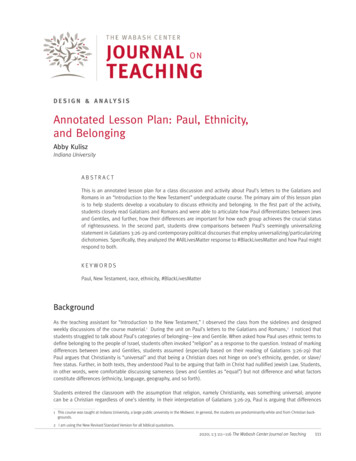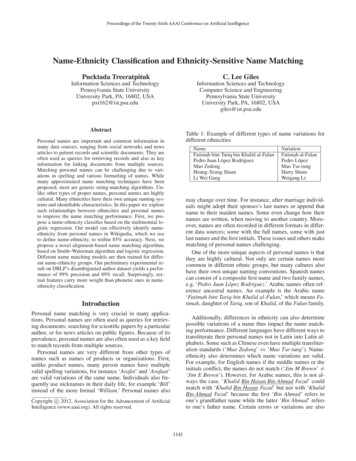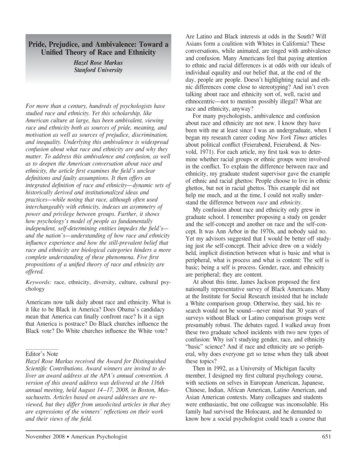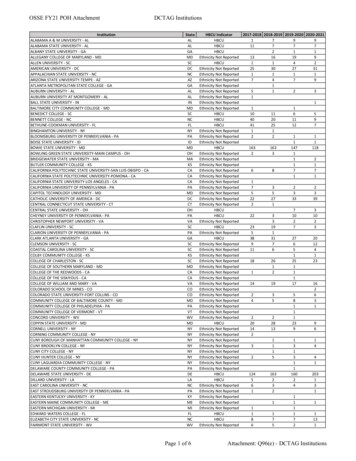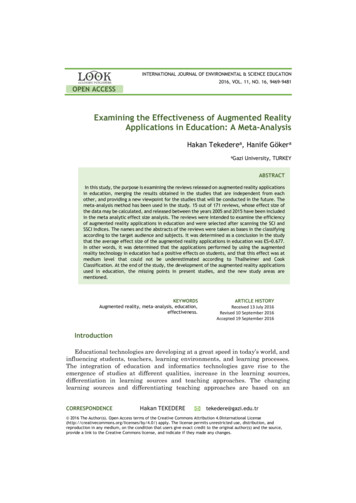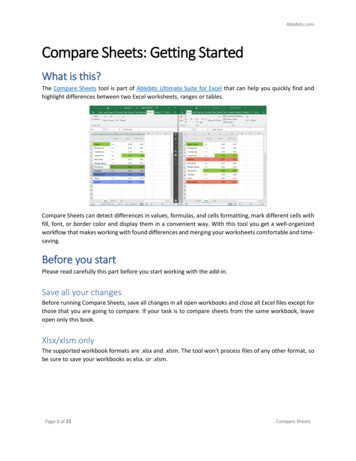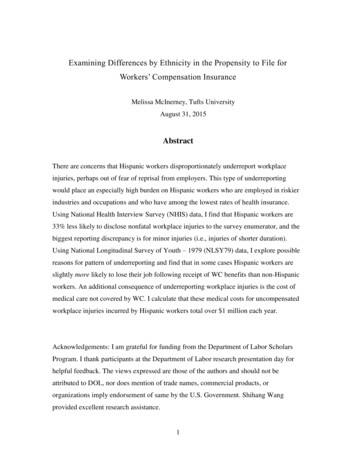
Transcription
Examining Differences by Ethnicity in the Propensity to File forWorkers’ Compensation InsuranceMelissa McInerney, Tufts UniversityAugust 31, 2015AbstractThere are concerns that Hispanic workers disproportionately underreport workplaceinjuries, perhaps out of fear of reprisal from employers. This type of underreportingwould place an especially high burden on Hispanic workers who are employed in riskierindustries and occupations and who have among the lowest rates of health insurance.Using National Health Interview Survey (NHIS) data, I find that Hispanic workers are33% less likely to disclose nonfatal workplace injuries to the survey enumerator, and thebiggest reporting discrepancy is for minor injuries (i.e., injuries of shorter duration).Using National Longitudinal Survey of Youth – 1979 (NLSY79) data, I explore possiblereasons for pattern of underreporting and find that in some cases Hispanic workers areslightly more likely to lose their job following receipt of WC benefits than non-Hispanicworkers. An additional consequence of underreporting workplace injuries is the cost ofmedical care not covered by WC. I calculate that these medical costs for uncompensatedworkplace injuries incurred by Hispanic workers total over 1 million each year.Acknowledgements: I am grateful for funding from the Department of Labor ScholarsProgram. I thank participants at the Department of Labor research presentation day forhelpful feedback. The views expressed are those of the authors and should not beattributed to DOL, nor does mention of trade names, commercial products, ororganizations imply endorsement of same by the U.S. Government. Shihang Wangprovided excellent research assistance.1
1. IntroductionHispanic workers are disproportionately employed in the most dangerous industries(Orrenius and Zavodny, 2009), and the most dangerous occupations, such as health aides,janitors and cleaners, maids and housekeepers, production workers, drivers, and handlaborers (Baron et al., 2013).1 Hispanic workers also have the highest rate of workplacefatalities of any group (Byer, 2013). It follows that Hispanic workers are at higher risk ofworkplace injury than non-Hispanic workers.In addition to concerns about Hispanic workers being at higher risk of workplace injury,the policy community is addressing fears about underreports of workplace injuries amongHispanic workers. In 2010, the Occupational Safety and Health Administration (OSHA)and the National Institute for Occupational Safety and Health (NIOSH) co-sponsored theNational Action Summit for Latino Worker and Health Safety.2 At this summit, HildaSolis, Secretary of Labor, said, “ too many workers, especially Latino workers do notreport violations. Many fear that they will lose their job or they fear discipline when theysuffer an injury.”3 The Director of NIOSH, John Howard, said, “ [i]t is likely, though,that non-fatal occupational injuries and illnesses are undercounted among Latinoworkers. These workers are reluctant to report injuries and illnesses.”4 Concerns aboutunderreporting workplace injuries are especially salient for Hispanic workers who are1In fact, 24% Hispanics are employed in high risk occupations relative to 21% of non-Hispanic no-summit.html Viewed July 6, 2015.3Ibid.4Ibid.2
employed in jobs with greater risk of injury and because Hispanic workers have amongthe lowest rates of health insurance of any demographic group.The existing empirical literature contributes to concerns about Hispanic underreporting ofnonfatal workplace injuries because evidence does not universally show that Hispanicworkers report more nonfatal workplace injuries than non-Hispanic workers. Smith et al.(2005) find that in the National Health Interview Survey (NHIS), the rate of nonfatalworkplace injury is lower for Hispanic workers than for whites. And prior estimatesexamining receipt of Workers’ Compensation (WC) insurance benefits, which cover thecost of medical care and lost wages for workers injured on the job, show that Hispanicworkers are less likely to receive WC cash payments than whites or blacks, conditionalupon benefit generosity, industry, and occupation (Bronchetti and McInerney, 2012). Infact, it is only when researchers restrict attention to the construction industry that theyfind evidence of Hispanic workers experiencing the same (Goodrum and Dai, 2005) orhigher rate of nonfatal injuries (Dong et al., 2010) than similar non-Hispanic workers.Together, this evidence is consistent with Hispanic workers underreporting workplaceinjuries in most industries.In this paper, I address two research questions in an attempt to quantify underreporting.First, I will examine whether Hispanic workers underreport both major and minornonfatal workplace injuries. Using the National Health Interview Survey (NHIS), I findthat underreporting is a larger problem for minor injuries than for major injuries. Second,I examine whether those Hispanic workers who report a nonfatal workplace injury to a3
national survey are less likely to file for WC or less likely to receive WC. To address thisquestion, I turn to the National Longitudinal Survey of Youth – 1979 (NLSY79), whichcaptures separate information regarding the incidence of injury, report of injury to one’semployer, and receipt of WC benefits.5 I find no evidence that, conditional on reportingan injury to a national survey, Hispanic workers who are injured on the job are any lesslikely to file for WC or receive WC benefits. An additional feature of the NLSY79 is theability to examine one of the hypothesized reasons why workers might underreportinjuries: fear of losing their job. The NLSY79 data asks whether workers were laid off orfired following their workplace injury. I find some evidence that Hispanic workers aremore likely to lose their jobs following receipt of WC benefits. This suggests thatHispanic workers might be rational in underreporting workplace injuries.2. BackgroundPrior work quantifies underreporting of workplace injuries/failure to file for WC benefitsand offers reasons why workers might not report an injury.6 However, this literature doesnot separately examine Hispanic or Latino workers. Nevertheless, the lessons from thisliterature can inform some of the reasons why Hispanic workers may be reluctant to file5The NHIS includes these questions in one year only, 2010, which does not yield a largeenough sample size of Hispanic workers who are injured on the job.6A large literature has examined the opposite concern: moral hazard in WC. Fortin andLanoie (1998) and Krueger and Meyer (2002) provide thorough reviews of this work. Ina recent update, Bronchetti and McInerney (2012) show that WC claims are notresponsive to benefit levels. In this section, I summarize the concurrent literatureexamining concerns about underreports of workplace injuries.4
for WC or report an injury to an employer.7 Some of these reasons include fear of reprisalfrom a worker’s current employer (Leigh et al., 2004; Fan et al., 2006; Boone and vanOurs, 2006); peer pressure to avoid reporting workplace injuries if an injury report wouldmake a work group ineligible for a safety bonus, such as a steak dinner or trip to Hawaii(Leigh et al., 2004); and some workers are uninformed of the process and their right tofile for WC (Leigh et al., 2004; Fan et al., 2006).This prior literature also offers lessons for how to quantify underreporting. One approachis to use a single dataset and examine whether an injured worker also reports filing a WCclaim. Fan et al. (2006) use a special module of the Behavioral Risk Factor SurveillanceSystem (BRFSS) for the state of Washington, which asks separate questions about theincidence of workplace injury and whether the individual filed a WC claim with theiremployer. They find that only 52% of injured workers filed a WC claim. The respondentswho indicated they experienced a work-related injury but did not file for WC report wereasked why they did not file. The most common response was that their medical costswere paid through their employer. However, a small share reported that they “did notknow they could file,” “worried about retaliation,” or “felt threatened byemployer/employer would not support.”7A separate literature examines why employers (not employees) might underreportinjuries. Leigh et al. (2004) finds that the Survey of Occupational Illnesses and Injuries(SOII) misses between 33 and 69 percent of all injuries. Boden and Ozonoff (2008)compare injuries reported to the SOII with data from state WC systems in six states andfind the BLS SOII misses a large share of workplace injuries, but also that a nontrivialnumber of workplace injuries are unreported to both WC systems and SOII.5
A related approach is to identify injury and WC receipt for the same individual, butwithout a single dataset capturing this information. Biddle and Roberts (2003) link WCadministrative data for the state of Michigan to a survey of physicians which identifiesevery patient who reported work-related pain in their back, wrist, hands, or shoulders.They find that a substantial share of workers (approximately one-third) who may beeligible for WC do not file for the benefits, and that nonwhite workers are less likely toreceive WC than white workers. In this paper, the analysis of the NLSY79 will followthis approach. In the NLSY79, I can observe individuals who report a workplace injuryand then observe whether these individuals also filed for WC or received WC.A second method is to examine patterns in the rates of different types of injury that mayor may not be underreported. Boone and van Ours (2006) follow this approach andcompare the rates of fatal and nonfatal injuries. Since fatal injuries are reporteduniversally, this rate is not sensitive to concerns about underreporting whereas the rate ofnonfatal injuries may be. The authors posit that workers are less likely to report nonfatalworkplace injuries to employers during poor economic times because the workers fearreprisal from their employer. They show that among OECD countries, when the nationalunemployment rises, the rate of nonfatal workplace injuries falls but the rate of fatalworkplace injuries remains constant. They interpret this as evidence of underreporting ofnonfatal injuries during economic downturns, perhaps because of fear of reprisal. In thispaper, analysis of the NHIS data will follow a similar approach by comparing patterns ofinjury for Hispanic versus non-Hispanic workers.6
Prior work has examined take-up of other social benefits among Hispanics andimmigrants and offers lessons why we might expect injury reporting (i.e., take-up) to bedifferent for Hispanic and non-Hispanic workers. First, family members may beconcerned about immigration enforcement. Watson (2014) shows that Medicaidparticipation among children whose parents are noncitizens declines as federalimmigration enforcement increases. She shows that this result holds even when thechildren are U.S. citizens. Aizer (2007) shows that overcoming language barriers (bymaking a bilingual application assistant available) increases take-up of Medicaid amongHispanic children. Therefore, in addition to the same concerns about job security andpeer pressure all workers may face when deciding whether or not to report a workplaceinjury, Hispanic workers may face additional concerns about immigration enforcement aswell as language barriers.3. Examining Underreporting in National Health Interview Survey (NHIS)Data3a. DataThe National Health Interview Survey (NHIS) is an annual, cross-sectional nationallyrepresentative household interview survey that is conducted by the National Center forHealth Statistics (NCHS), a part of the Centers for Disease Control and Prevention(CDC). The NHIS provides information on the health of the US population, and since1997 the survey also contains detailed information about injuries experienced by allhousehold members. Respondents are asked to report each injury or poisoning that7
required medical care for any household member within three months of the survey. Forthose injuries for which a medical professional was consulted, respondents are askedwhat activity the injured household member was engaged in at the time of injury,including “working at a paid job.” The survey also includes information regarding daysof work missed, diagnosis, and where the respondent received care. The NHIS alsocontains detailed information about a worker’s industry and occupation for one randomlyselected “sample adult” in each household. For this analysis, I restrict attention to sampleadult respondents for the 1997 through 2013 NHIS, a sample of 180,520 workers (33,487Hispanic workers) and 1,650 workers who report a workplace injury (266 Hispanicworkers). See Appendix Table 1 for sample construction details.There are four important limitations to the NHIS data that must be addressed. First,Hispanics are a heterogeneous group. It may not be appropriate to combine workers whoreport Hispanic ethnicity but have different countries of origin. Unfortunately, thenumber of injured Hispanic workers in the sample is so small that I am unable toseparately examine incidence of injury by country of origin. Although this is a limitation,it is consistent with much work on Hispanic take-up of social programs (see, for example,Bronchetti, 2014; Aizer, 2007; Watson, 2014) and Hispanic wage gaps (see, for example,McHenry and McInerney, 2015).The second limitation is that the NHIS does not contain any information regardingwhether the worker reports the injury to his or her employer (or files for WC). Therefore,if injured workers are more likely to report injuries to NHIS enumerators than to8
employers, then results from the NHIS are likely to understate the amount ofunderreporting by Hispanic injured workers. To overcome this limitation, I also includeanalysis of the NLSY79 which captures the incidence of injury as well as reporting theinjury to one’s employer.A third limitation is concern that the NHIS may not be representative of the workforceand the distribution of industry (and corresponding risk of injury). I can address thisconcern by examining how well characteristics of NHIS respondents match respondentsto the CPS. Table 1 compares adults in the NHIS with adults in the Current PopulationSurvey (CPS). Hispanic respondents in the NHIS are not perfectly representative ofHispanic respondents to the CPS; to address these concerns in my empirical work, I willinclude controls for observable characteristics. Table 2 shows how the distribution ofindustry among workers in the NHIS approximates the distribution of industry amongworkers in the CPS. Although the NHIS data do not perfectly match the distribution ofindustry among workers in the CPS, there are several dangerous industries in whichHispanic workers in the NHIS are more heavily concentrated than Hispanic workers inthe CPS: construction, manufacturing, wholesale and retail trade, and agriculture.Therefore, although the distribution of industry among Hispanics in the NHIS does notmatch the distribution in the CPS, it is not the case that Hispanic respondents in the NHISare exclusively sorted into safer industries.The final concern with the NHIS data is that of recall bias, which arises when there isdifferential recall of information across two different groups. Ruser (2008) raises the9
concern of recall bias in the NHIS survey data, citing evidence that workers have beenfound to forget about minor injuries after approximately six weeks. If Hispanic workersrecall fewer injuries than non-Hispanic workers, I might erroneously be ascribingunderreporting to differential recall. To examine concerns about recall bias, I examinewhether any differential between Hispanic and non-Hispanic injuries is eliminated whenthe recall period is shorter. In Table 3, I examine injuries that occurred in the year prior tothe interview.8 Although it appears that recall bias explains some of the difference in nonwork-related injury rates between Hispanic and non-Hispanic workers, it does not explainthe whole differential. The gap between the rate of workplace injury between Hispanicand non-Hispanic injuries falls when the recall period shrinks from one year to the samequarter as the interview. However, even when considering injuries that occurred in thesame quarter of interview, Hispanic workers are less likely to disclose a work-relatedinjury. In this analysis, I use the horizon of one year from the interview in order tomaximize the number of injuries in the sample.3b. Conceptual FrameworkThe analysis below makes several assumptions about the likelihood of injury at work andthe relationship between the disclosure of a workplace injury to a survey enumerator andreport of a workplace injury to the worker’s employer. The empirical approach rests onthe underlying assumption that, conditional on observable characteristics, the underlyingrisk of injury is the same for Hispanic workers as it is for workers of other races andethnicities. I also assume that injured workers are more likely to disclose workplaceinjuries to survey enumerators than to employers. That is, I assume that all workplace8Warner et al. (2005) recommend using a five-week recall period to examine injuries inthe NHIS beginning with the 2004 survey. With the publicly available NHIS data, I donot observe the exact date of interview, just interview quarter, month, or week.10
injuries that are reported to employers are disclosed to survey enumerators. This meansthat estimates from the NHIS are likely to understate the extent of underreporting if moreinjuries are disclosed to the NHIS than to employers.From these assumptions, the empirical approach follows from the literature on wage gapsby race and ethnicity. That is, I control for all observable determinants of report of aworkplace injury in addition to an indicator for Hispanic ethnicity, as in the linearprobability model presented in equation (1) below. If, conditional on observablesHispanic workers are equally likely to report workplace injuries, then the coefficientestimate for 𝛽 will be zero. In contrast, a negative coefficient for 𝛽 would be consistentwith Hispanic workers being less likely to report workplace injuries than �𝑢𝑟𝑦𝑖,𝑡 𝛼 𝛽𝐻𝑖𝑠𝑝𝑖 𝛾𝐵𝑙𝑘𝑖 δ𝑂𝑡ℎ𝑅𝑎𝑐𝑒𝐸𝑡ℎ𝑖 Γ𝑋𝑖,𝑡 𝜃𝑡 𝜀𝑖,𝑡Where X is a vector of worker characteristics, including citizenship status, age, gender,marital status, educational attainment, industry, occupation, and year fixed effects.Because the dependent variable is binary, I also present results from probit models.93c. ResultsThe results presented in Table 4 show the impact of observable characteristics on thelikelihood of disclosing a workplace injury to the NHIS. I first describe the estimated9In future work, I will incorporate state fixed effects to control for permanent differencesacross states and state-specific WC benefit generosity, which changes over time andvaries across workers with different levels of earnings. This requires access to therestricted use NHIS. At this time, my proposal has been approved but I am still awaitingfinal approval of my Special Sworn Status to access the data at the Boston CensusResearch Data Center (RDC).11
effects for observable determinants of injury report common to all races and ethnicities.The effects are largely as expected: younger workers are more likely to disclose aworkplace injury, as are less educated workers, and workers employed in more dangerousindustries and occupations. US citizens are also more likely than non-citizens to disclosean injury to the NHIS. Even conditional on all of these observable characteristics,Hispanic workers are less likely to disclose a workplace injury to the NHIS than whiteworkers. In fact, Hispanic workers are 0.3 percentage points less likely to disclose aworkplace injury to the NHIS than a similar white worker. With a mean rate of nonfatalworkplace injury of 0.9 percent of all NHIS respondents disclosing an injury to thesurvey enumerator, this means Hispanic workers are one third less likely to disclose aworkplace injury than white workers.This effect is not unique to Hispanic workers; as shown in Table 4, black workers arealso less likely than white workers to disclose nonfatal workplace injuries to surveyenumerators, though the effect size is smaller. Nor is this effect solely driven byundocumented Hispanic workers. As shown in columns (3) and (4), the effect persistswhen the sample is restricted to US citizens.Of course, I cannot rule out an alternative explanation that is consistent with thesefindings—it may be that the distribution of injury severity for Hispanic workers lies tothe right of the corresponding distribution of injury severity for white workers. In theanalysis that follows, I attempt to distinguish between these two alternative explanations.12
In Table 5, I examine the likelihood of reporting injuries of different severity. Thisexercise will allow me to identify the biggest gaps in injury reports. Panel A in Table 5replicates the main results from Table 4 for injuries of all durations. Panels B through Dcontain results examining the likelihood that Hispanic workers disclose injuries ofdifferent duration: injuries for which a worker misses less than a full day of work, missesbetween one and five days of work, and misses six or more days of work. As shown inTable 5, the biggest gap in reported injuries arises among the least severe injuries—thecoefficient estimate falls in magnitude moving down the table to the most severe injuries.Hispanic workers are 0.21 percentage points less likely to disclose injuries resulting inless than one full day of missed work to the NHIS but only 0.06 percentage points lesslikely to disclose injuries resulting six or more days of work. In addition, the impactrelative to the mean is larger for the least severe injuries: Hispanic workers are 46 percentless likely to disclose the least severe injuries and only 30 percent less likely to disclosethe most severe injuries. In Panel E of Table 5, I quantify severity as a hospital stay andfind no difference between Hispanic and white workers. Of course, the results presentedin Table 5 are consistent with both underreporting of less severe injuries as well as a shiftto the right in the distribution of injury severity. In the analysis that follows, I attempt todistinguish between these two alternative explanations.One way to attempt to identify underreporting is to compare effects among a subset ofinjuries that prior work has identified as more sensitive to reporting incentives versus theeffects among a sample of injuries identified as less sensitive to reporting incentives.Prior work examining the WC program has identified cuts, fractures, and burns as13
“traumatic” injuries which are less sensitive to incentives to under- or over-report andback sprains and repetitive trauma injuries (e.g., carpal tunnel syndrome) as “nontraumatic” injuries which are more sensitive to incentives to under- or over-report(Biddle, 2001; Biddle and Roberts, 2003; McInerney, 2010; Ruser, 1998). Concerns ofunderreport would likely be larger among “non-traumatic” injuries, and in Table 6 Iseparately examine differences by ethnicity in the report of traumatic versus nontraumatic injuries. As shown in Table 6, there are no statistically significant gaps inreport of traumatic injury between Hispanic and white workers. In contrast, there arestatistically significant differences in the report of non-traumatic injuries, which issuggestive of underreporting. Among the sample of non-traumatic injuries, Hispanicworkers are 0.1 percentage points less likely to report a workplace injury than a similarwhite worker. With a mean injury rate of 0.3 percent of workers reporting workplaceinjuries, this is a large effect reflecting Hispanic workers being 30% less likely to reportworkplace injuries.Another way to examine whether the results reflect underreporting or a shift in thedistribution of injury severity is to consider the cost associated with reporting (or notreporting) an injury. For workers lacking health insurance, there are larger financialbenefits to having the medical care associated with an injury covered by WC, since thecost of any medical care would be out of pocket for these workers. Therefore, it issomewhat surprising in Table 7 to see that injury disclosing discrepancies are largestamong those lacking health insurance. It may be the case that health insurance is14
correlated with job security.10 To better examine whether workers with lower levels ofjob security are less likely to disclose a nonfatal injury In Panels D and E, I instead splitthe sample of workers by those who are paid by the hour versus those who are salaried.Consistent with those Hispanic workers who have the least secure jobs being the mostlikely to underreport, I find the biggest discrepancy in injury disclosure to the NHISamong those who are paid by the hour.In summary, analysis of the NHIS data is consistent with Hispanic workersunderreporting minor workplace injuries to NHIS enumerators (and, presumably) theiremployers. The ethnic differential is larger for those non-traumatic injuries which havebeen shown to be more responsive to incentives in WC, and it is also larger for workerswho lack health insurance and who are paid by the hour. To examine whether Hispanicrespondents who report injuries to survey enumerators are any less likely to file for WC(or receive WC, conditional on filing), I now turn to the NLSY79 data which separatelyasks questions on workplace injury and report of injury to one’s employer. With theNLSY79, I am also able to test reasons for underreport.10Recall that the NHIS analysis spans the years 1997 through 2013, so ended before thehealth insurance mandates from the Affordable Care Act (ACA) were implemented.15
4. Examining Rates of Workers’ Compensation Receipt with the NationalLongitudinal Survey of Youth 1979 (NLSY79)4a. DataThe NLSY79 is a longitudinal survey of approximately 10,000 individuals, conducted bythe Bureau of Labor Statistics. The NLSY79 includes questions regarding the incidenceof workplace injuries in the 1988, 1989, 1990, 1992, 1994, 1996, 1998, and 2000 surveys.Whereas the NHIS asked about any injury that required medical care, the NLSY79 asksrespondents to report “ any incident at any job we previously discussed that resulted ininjury or illness to you?” The NLSY79 does not ask whether the injured worker receivedmedical care for the injury. See Appendix Table 2 for more details on sampleconstruction of the NLSY79 data. The first key advantage of the NLSY79 data is that Iam able to observe whether injured workers filed a WC claim with their employers ornot. And, conditional on filing a claim, did the individual receive WC benefits. Thesecond key advantage of this dataset is that I also observe whether an injured worker wasterminated from his or her job following a workplace injury (or report of a workplaceinjury). For each workplace injury, the NLSY79 questionnaire asks “Did theillness/injury cause you to be laid off?” and “Did the illness/injury cause you to befired?”16
As shown in Table 8, in the NLSY79 data, Hispanic workers have no greater propensityto file for (and receive) WC, conditional on injury.11 Surprisingly, Hispanic workers aremore likely to be terminated following a workplace injury or report of injury.4b. Empirical approachTo examine whether Hispanic workers are any less likely to file for WC, conditional onexperiencing an injury, I estimate the following linear probability model.(2) 𝐹𝑖𝑙𝑒𝐹𝑜𝑟𝑊𝐶𝑖𝑠𝑡 𝛼 𝛽𝐻𝑖𝑠𝑝𝑎𝑛𝑖𝑐𝑖 Γ𝑋𝑖𝑠𝑡 𝜃𝑡 𝜃𝑠 𝜀𝑖𝑠𝑡The vector X includes the same controls from the analysis of the NHIS data, and, sincethe analysis is now restricted to the sample of injuries, I am also able to control for injuryduration and type of injury. Because I have access to the restricted use NLSY79 data, Iam now able to identify the respondent’s state of residence. This enables me to includestate effects to control for permanent differences in WC programs across states, includingthe generosity of WC cash benefits.11In addition to including a broader definition of injury than the NHIS (since it does notcondition on medical care receipt), the design of the NLSY79 may result in fewerconcerns about respondents failing to disclose workplace injuries to survey enumerators.By the time the first question regarding workplace injury was asked of surveyrespondents, respondents in this longitudinal panel had participated in nine rounds of thesurvey. Therefore, survey respondents likely had fewer concerns about a disclosed injurybeing shared with their employer since they had experience with the confidentiality of thesurvey.17
I also conduct a similar analysis to examine whether Hispanic workers are any less likelyto receive WC, conditional on filing a claim:(3) 𝑅𝑒𝑐𝑒𝑖𝑣𝑒𝑊𝐶𝑖𝑠𝑡 𝛼 𝛽𝐻𝑖𝑠𝑝𝑎𝑛𝑖𝑐𝑖 Γ𝑋𝑖𝑠𝑡 𝜃𝑡 𝜃𝑠 𝜀𝑖𝑠𝑡A finding that the coefficient estimate for 𝛽 is negative would be consistent withHispanic workers being less likely to file for WC (or receive WC), conditional upon aworkplace injury (or filing a WC claim). As with the analysis of the NHIS data, I alsopresent results from probit models.Following a similar approach, I examine what happens to injured workers’ jobs. I runlinear probability models (and probits) examining whether Hispanic injured workers areany more or less likely to be terminated from their jobs following an injury or report ofan injury.4c. ResultsThe results are presented in Panel A of Table 9. Among all injured respondents,conditional on reporting a workplace injury to a survey enumerator, there is littleevidence that Hispanic workers are any more or less likely to file for WC with theiremployer. In fact, in the case of citizen respondents to the NLSY79, Hispanic workers
examining receipt of Workers' Compensation (WC) insurance benefits, which cover the cost of medical care and lost wages for workers injured on the job, show that Hispanic workers are less likely to receive WC cash payments than whites or blacks, conditional upon benefit generosity, industry, and occupation (Bronchetti and McInerney, 2012). In
